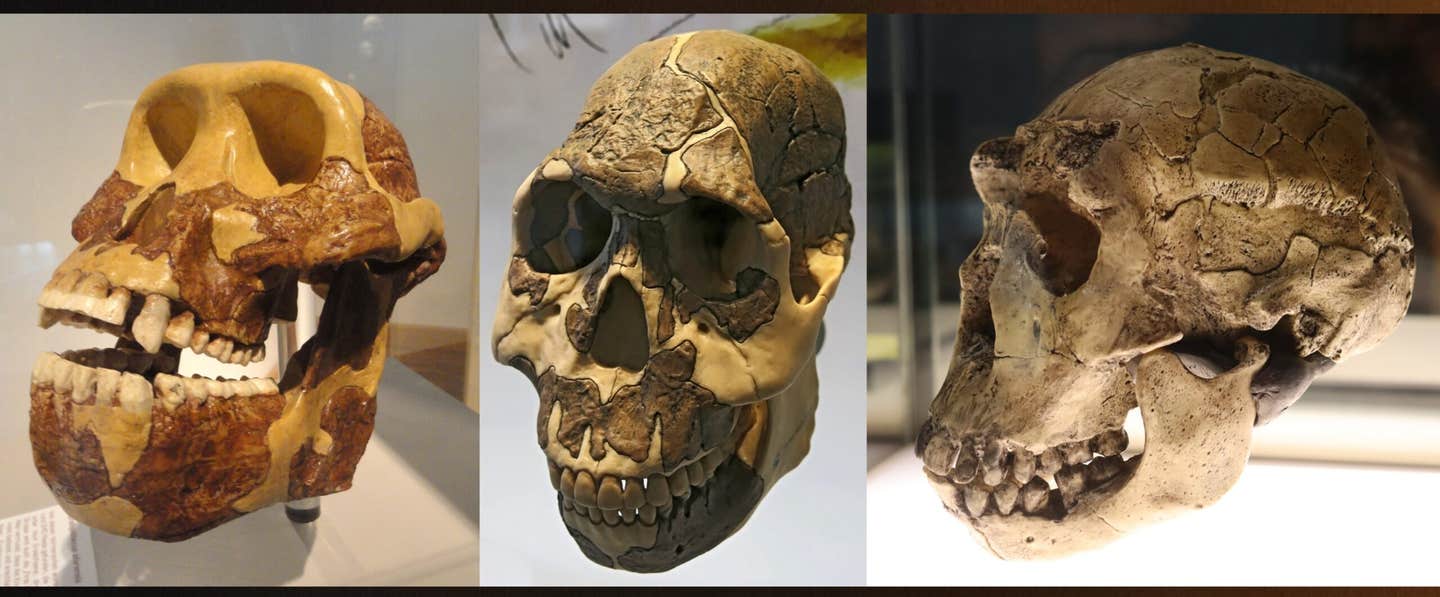Fossilized teeth reveal a risky diet change spurred human evolution
A new study led by researchers at Dartmouth College provides the first direct proof from the human fossil record for a powerful evolutionary force.

Chronologically from left, the molars of human ancestors got longer over millennia to suit a diet of high-carb grassy plants. (CREDIT: Public domain; Don Hitchcock; Fernando Losada Rodríguez (rotated))
A timeless question has always fascinated scientists who study the past. Which comes first, the new behavior or the physical tool that perfects it? Do you change how you live and then evolve the body to match? Or do you evolve a new physical trait that unlocks a new way of life? For a long time, this has been a difficult puzzle to solve. Behavior, after all, does not turn into a fossil. You cannot dig up a decision your ancient ancestors made millions of years ago.
Now, a new study led by researchers at Dartmouth College has found a stunning answer locked inside ancient teeth. It provides the first direct proof from the human fossil record for a powerful evolutionary force. The findings, published in the journal Science, show that for your ancient relatives, behavior was in the driver's seat.
They bravely adopted new diets and lifestyles long before their bodies had the ideal tools to do so. This willingness to change, to be flexible, may be the very thing that set our human lineage on its unique path. This process, where a new way of life actually propels physical change over thousands of years, is known as behavioral drive.
The Challenge of Seeing the Past
Scientists have long argued that major shifts in animal behavior can be the starting engine for evolution. Great thinkers like Darwin and Mayr championed this idea. They suggested that when a species tries something new, like moving to a new habitat or eating a new food, it enters a whole new world of challenges. Over immense stretches of time, this can lead to the evolution of new physical traits that help the species succeed. This is the core concept of behavioral drive. It suggests that how you act can eventually reshape your body.
But proving this in the fossil record is incredibly tricky. Nathaniel Dominy, a professor of anthropology at Dartmouth and senior author of the study, explains the problem. "Anthropologists often assume behaviors on the basis of morphological traits, but these traits can take a long time—a half-million years or more––to appear in the fossil record," Dominy says.
If you only look at the bones, you might miss the real story. You could miss the long period where your ancestors were "making it work" with the bodies they had, not the bodies they needed. To truly test the idea of behavioral drive, scientists needed a way to measure behavior that was completely separate from the shape of the bones. They needed a clue that was independent of the fossils' physical form.
Related Stories
- Denisovan jawbone discovery unlocks secrets of ancient human migration
- Ancient tooth fossil reveals humans have been getting high for over 4,000 years
- New fossil evidence places early humans in Eurasia 2 million years ago
A Dietary Diary and Behavioral Drive in Human Evolution
That special clue was found in the chemical makeup of fossilized teeth. Teeth are like tiny time capsules. As they form, they lock in chemical signatures from the food an animal eats. Think of it as a permanent dietary diary written in isotopes. Plants use different methods of photosynthesis.
This leaves them with different ratios of carbon isotopes. By analyzing these isotopes in tooth enamel, scientists can tell if your ancestors were eating leafy trees and shrubs or if they were eating tropical grasses and sedges. These grassy plants are known as graminoids.
The Dartmouth-led team used this technique to look at a curious mystery in the primate family tree. Around four million years ago, at least three different types of primates started eating a lot of grass. This included a giant baboon-like monkey, a leaf-eating monkey, and our own ancestors, the hominins.
This was strange. Most animals that live on grass have special adaptations, like super long teeth or complex stomachs like a cow. These primates did not. Yet they all started eating these tough, fibrous plants. The team now had a way to track the behavior—eating grass—separately from the physical trait of having grass-chewing teeth. This was the key to unlocking the secrets of behavioral drive in human evolution.
Astonishing Results
The results were astonishing. The chemical signatures in the teeth showed a clear story. Your ancient relatives started feasting on these grassy plants long before their teeth were truly built for the job. Luke Fannin, a postdoctoral researcher at Dartmouth and the study's lead author, found that this dietary change happened a staggering 700,000 years before their teeth evolved to become better grass-grinders.
For nearly three-quarters of a million years, your ancestors were driven by their behavior, not their biology. "We can definitively say that hominins were quite flexible when it came to behavior and this was their advantage," Fannin says. "But we found that behavior could be a force of evolution in its own right, with major repercussions for the morphological and dietary trajectory of hominins."
Unlocking an Underground Banquet
The story gets even more interesting. After millions of years of eating grasses, the team saw another abrupt shift in the hominin diet around 2.3 million years ago. The isotope ratios in the teeth of an early human ancestor, Homo rudolfensis, suddenly plummeted. The researchers considered several explanations. The most compelling one points to a new, game-changing food source: underground plant parts. Your ancestors had learned to dig. They were now eating things like starchy tubers, bulbs, and corms. Think of them as the wild potatoes and onions of ancient Africa.
This was a brilliant move. These underground foods were packed with carbohydrates, providing a huge energy boost for their growing bodies and expanding brains. They were available year-round, making them a much more reliable food source than seasonal fruits or seeds. And by using simple stone tools, which they had already adopted, early humans could access this underground buffet with little competition from other animals.
"We propose that this shift to underground foods was a signal moment in our evolution," Fannin says. "It created a glut of carbs that were perennial—our ancestors could access them at any time of year to feed themselves and other people." This discovery further supports the power of behavioral drive in human evolution, as they adapted their foraging strategies to exploit a novel, high-reward resource.
Our Adaptable Ancestors
For millions of years, the behavior of your ancestors outpaced their physical evolution. They were trying new things and succeeding despite their physical limitations. Then, around 2 million years ago, the team noticed that evolution started to catch up.
The teeth of later human ancestors like Homo habilis and Homo ergaster showed a spurt of change. Their molars became longer and better suited for chewing the tougher foods they had been eating for so long. Eventually, they would also harness fire, making these underground foods even easier to digest.
This entire journey highlights what may be humanity's greatest strength: our incredible flexibility. While other primates also experimented with eating grass, they didn't follow the same path. Hominins did something different. They paired their new diet with tool use and a growing intelligence. They solved problems with their minds and their actions, not just their bodies. This pattern of behavioral drive in human evolution set our lineage apart.
"One of the burning questions in anthropology is what did hominins do differently that other primates didn't do? This work shows that the ability to exploit grass tissues may be our secret sauce," Dominy says. It’s a legacy that continues today. Our entire global civilization is built upon a few species of grass: rice, wheat, corn, and barley.
Your ancestors took a risk millions of years ago, trying a new food that nobody thought they could eat. That single behavioral shift may have changed the game for all of life on Earth, setting in motion the long, winding evolutionary journey that led directly to you.
Note: The article above provided above by The Brighter Side of News.
Like these kind of feel good stories? Get The Brighter Side of News' newsletter.



